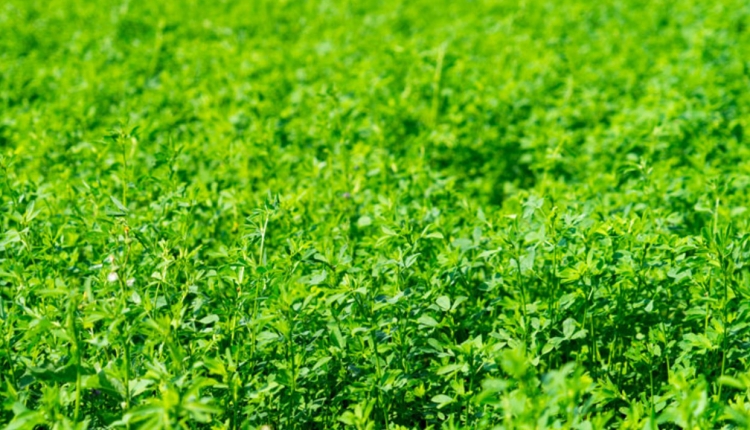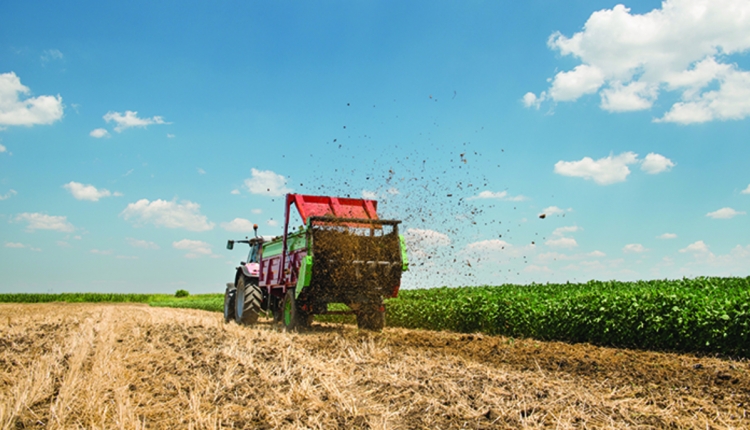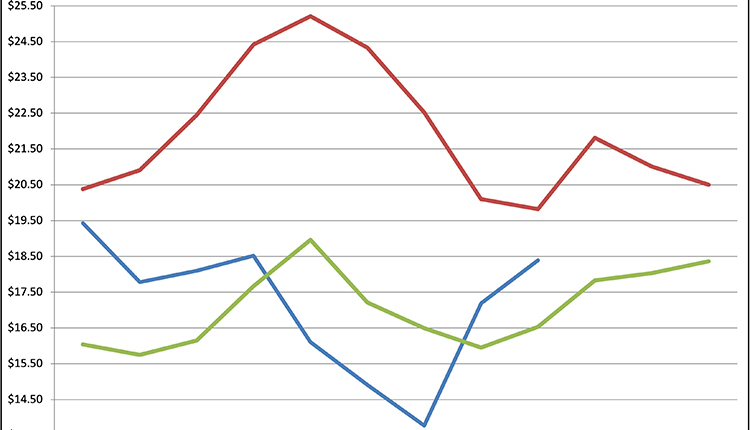If the appropriate conditions are met, late summer alfalfa seeding is an opportunity you should take advantage of. According to Dan Undersander, extension forage agronomist at the University of Wisconsin, Madison, late summer seeding is an excellent way to re-establish stands and is actually the preferred time of year to seed in many regions.
"Your decision to summer seed should be based on weather conditions (temperature), available soil moisture, and your projected forage needs (the importance of having a fully productive alfalfa stand available next spring versus direct seeding)," Undersander stated.
There are numerous advantages to late summer seeding. Alfalfa can be seeded following the summer harvest, weeds are primarily controlled by preplant cultivation or burn down which reduces the need for herbicides, and you have more time for proper seedbed preparation.
"Summer seeding also boosts first-year yields compared to spring seeding. With a spring planting, 40 to 60 percent of full season yields are expected. A late summer planting can result in approximately 90 percent of a full-season yield the following year," he noted.
When conditions are right
Before deciding to summer seed, Undersander recommends evaluating 10 criteria to maximize your chances of obtaining a strong alfalfa stand the following spring.
Plant only if conditions are right. Never seed into dry soils. A light rain (1/2 inch or less) can germinate seed, but the new seedling could die from drought in a matter of days if no additional rain is received. You must control weeds prior to seeding.
Plant at the proper date. Next to dry soil, planting too late is the biggest cause of summer seeding failures. Actual dates will vary based on moisture availability and temperatures. It is crucial to get at least 45 frost-free days of good growing conditions after seeding to build up adequate carbohydrate reserves for winter.
You want to plant late enough that alfalfa will not regrow, but, erring on the side of caution, it is better to seed earlier rather than later into the late summer. If you include grasses in the mix, planting earlier in August can yield well the following spring.
Alfalfa autotoxicity. Alfalfa plants produce a toxin that can reduce root development and survival of new seedlings. If you are reseeding into a previous alfalfa stand, you need a waiting period to provide all toxin degraded out of the root zone. You can reseed immediately into a failed spring seeding (or from the previous fall). If an alfalfa stand is 2 or more years old, he recommends waiting two years before reseeding.
Fertility. Before summer planting, have your soil tested, and follow lime and fertilizer recommendations for phosphorus (P), potassium (K), and sulfur (S). The optimum pH level is 6.8, and liming should occur six to 24 months prior to planting. Maintaining P levels is critical to proper root and seedling development, while K increases yields and stand persistence. Additionally, fields with high available nitrogen levels may delay or prevent the formation of nodules.
Seed bed preparation. Tillage is important to control perennial weeds, but overtilling can dry out soil. Soil firmness is critical to ensure proper soil-to-seed contact and preserve soil moisture. Packing soil before and after planting gives the best results. If you are seeding into stubble, make sure you have good soil-to-seed contact and proper planting depths.
Seeding methods. Undersander recommends the same seeding rates and methods for late summer as for spring seedings. Seeders need to have press wheels or you need a cultipacker to optimize seed-to-soil contact for fast establishment. No-till seeders should have heavy down pressure, coulters ahead of disk openers, and press wheels with a depth control mechanism.
Planting depth. The ideal planting depth is 1/4 inch. Seeds should not be planted deeper than 1/2 inch. Prepacking soil firmly can help control seed depth; prepacking is especially critical if soil is dry.
Weed control. Use a burn-down herbicide before planting to control perennial weeds and destroy any remaining vegetative growth from the previous crop. Avoid using a cover crop for weed control in the summer as it outcompetes alfalfa for critical moisture. If weeds (like volunteer wheat) infest the newly seeded stand, contact your agronomist about postemergent herbicides. Avoid clipping to reduce weed competition with fall seedings.
Postseeding considerations. Do not harvest any alfalfa the first fall unless you have no other feed options. Fall harvesting of summer seeding will most likely result in stand losses over the first winter, reducing long-term productivity. If you need feed, cut after alfalfa plants have gone into dormancy. Do not fall graze new seedings with cattle or subject to machine traffic. If there's significant weed competition in the spring, use herbicides to clean up the field as early as possible.
Variety selection criteria. Plant alfalfa varieties with high genetic potential for yields, quality, persistence, and pest resistance you will need for maximum long-term performance from your alfalfa stand, recommends Undersander. Coated alfalfa seed is often beneficial for late summer seeding as its hydroscopic trait seeks out available moisture to speed germination and overall establishment.
Choose varieties that are resistant to all major alfalfa diseases in your area. Seedling diseases are not as important in the late summer seeding as for spring seeding, but major diseases are still key factors for persistence. Finally, selecting varieties with a low winter survival score (more winter hardy) and high resistance to root and crown diseases are your best choice for winter survival.
While summer seeding can be advantageous in many situations, if environmental and agronomic conditions are not right, your chances of having a good alfalfa stand the following spring are diminished.
There are four key disadvantages, according to Undersander, that must be taken into account prior to making the summer seeding decision:
• Soil moisture
• Temperature
• Frost dates
• Herbicide carryover
Shortages of moisture, extreme high temperatures, and herbicide carryover all could result in reduced stand densities or cause stand loss. If it is too dry at seeding time, you run the risk of seed germinating too late to get enough growth to survive the winter. Additionally, frost damage may occur if recommended planting dates are not followed or early frost occurs.
Location and the other crops in your rotation may limit the success of late summer seeding. In the Midwest specifically, seeding may present a challenge due to droughts during this time period. Northern states may also be presented with rotation problems due to a shorter growing season. In southern states, fewer obstacles hinder late summer planting; weed control is less problematic and alfalfa can be planted after another crop in early to mid-September.
"While late summer seedings have some risks, they offer many advantages for establishing strong, productive alfalfa stands to maximize alfalfa yields and profitability," noted Undersander.
Click here to return to the Crops & Forages E-Sources
110825_544
"Your decision to summer seed should be based on weather conditions (temperature), available soil moisture, and your projected forage needs (the importance of having a fully productive alfalfa stand available next spring versus direct seeding)," Undersander stated.
There are numerous advantages to late summer seeding. Alfalfa can be seeded following the summer harvest, weeds are primarily controlled by preplant cultivation or burn down which reduces the need for herbicides, and you have more time for proper seedbed preparation.
"Summer seeding also boosts first-year yields compared to spring seeding. With a spring planting, 40 to 60 percent of full season yields are expected. A late summer planting can result in approximately 90 percent of a full-season yield the following year," he noted.
When conditions are right
Before deciding to summer seed, Undersander recommends evaluating 10 criteria to maximize your chances of obtaining a strong alfalfa stand the following spring.
Plant only if conditions are right. Never seed into dry soils. A light rain (1/2 inch or less) can germinate seed, but the new seedling could die from drought in a matter of days if no additional rain is received. You must control weeds prior to seeding.
Plant at the proper date. Next to dry soil, planting too late is the biggest cause of summer seeding failures. Actual dates will vary based on moisture availability and temperatures. It is crucial to get at least 45 frost-free days of good growing conditions after seeding to build up adequate carbohydrate reserves for winter.
You want to plant late enough that alfalfa will not regrow, but, erring on the side of caution, it is better to seed earlier rather than later into the late summer. If you include grasses in the mix, planting earlier in August can yield well the following spring.
Alfalfa autotoxicity. Alfalfa plants produce a toxin that can reduce root development and survival of new seedlings. If you are reseeding into a previous alfalfa stand, you need a waiting period to provide all toxin degraded out of the root zone. You can reseed immediately into a failed spring seeding (or from the previous fall). If an alfalfa stand is 2 or more years old, he recommends waiting two years before reseeding.
Fertility. Before summer planting, have your soil tested, and follow lime and fertilizer recommendations for phosphorus (P), potassium (K), and sulfur (S). The optimum pH level is 6.8, and liming should occur six to 24 months prior to planting. Maintaining P levels is critical to proper root and seedling development, while K increases yields and stand persistence. Additionally, fields with high available nitrogen levels may delay or prevent the formation of nodules.
Seed bed preparation. Tillage is important to control perennial weeds, but overtilling can dry out soil. Soil firmness is critical to ensure proper soil-to-seed contact and preserve soil moisture. Packing soil before and after planting gives the best results. If you are seeding into stubble, make sure you have good soil-to-seed contact and proper planting depths.
Seeding methods. Undersander recommends the same seeding rates and methods for late summer as for spring seedings. Seeders need to have press wheels or you need a cultipacker to optimize seed-to-soil contact for fast establishment. No-till seeders should have heavy down pressure, coulters ahead of disk openers, and press wheels with a depth control mechanism.
Planting depth. The ideal planting depth is 1/4 inch. Seeds should not be planted deeper than 1/2 inch. Prepacking soil firmly can help control seed depth; prepacking is especially critical if soil is dry.
Weed control. Use a burn-down herbicide before planting to control perennial weeds and destroy any remaining vegetative growth from the previous crop. Avoid using a cover crop for weed control in the summer as it outcompetes alfalfa for critical moisture. If weeds (like volunteer wheat) infest the newly seeded stand, contact your agronomist about postemergent herbicides. Avoid clipping to reduce weed competition with fall seedings.
Postseeding considerations. Do not harvest any alfalfa the first fall unless you have no other feed options. Fall harvesting of summer seeding will most likely result in stand losses over the first winter, reducing long-term productivity. If you need feed, cut after alfalfa plants have gone into dormancy. Do not fall graze new seedings with cattle or subject to machine traffic. If there's significant weed competition in the spring, use herbicides to clean up the field as early as possible.
Variety selection criteria. Plant alfalfa varieties with high genetic potential for yields, quality, persistence, and pest resistance you will need for maximum long-term performance from your alfalfa stand, recommends Undersander. Coated alfalfa seed is often beneficial for late summer seeding as its hydroscopic trait seeks out available moisture to speed germination and overall establishment.
Choose varieties that are resistant to all major alfalfa diseases in your area. Seedling diseases are not as important in the late summer seeding as for spring seeding, but major diseases are still key factors for persistence. Finally, selecting varieties with a low winter survival score (more winter hardy) and high resistance to root and crown diseases are your best choice for winter survival.
Not for everyone
While summer seeding can be advantageous in many situations, if environmental and agronomic conditions are not right, your chances of having a good alfalfa stand the following spring are diminished.
There are four key disadvantages, according to Undersander, that must be taken into account prior to making the summer seeding decision:
• Soil moisture
• Temperature
• Frost dates
• Herbicide carryover
Shortages of moisture, extreme high temperatures, and herbicide carryover all could result in reduced stand densities or cause stand loss. If it is too dry at seeding time, you run the risk of seed germinating too late to get enough growth to survive the winter. Additionally, frost damage may occur if recommended planting dates are not followed or early frost occurs.
Location and the other crops in your rotation may limit the success of late summer seeding. In the Midwest specifically, seeding may present a challenge due to droughts during this time period. Northern states may also be presented with rotation problems due to a shorter growing season. In southern states, fewer obstacles hinder late summer planting; weed control is less problematic and alfalfa can be planted after another crop in early to mid-September.
"While late summer seedings have some risks, they offer many advantages for establishing strong, productive alfalfa stands to maximize alfalfa yields and profitability," noted Undersander.
110825_544

















